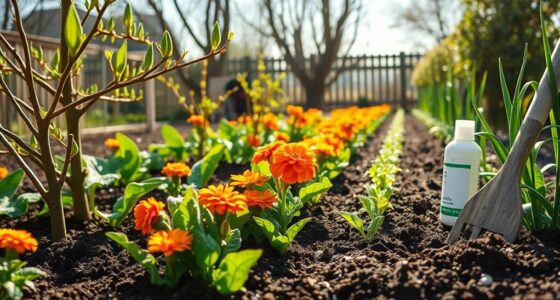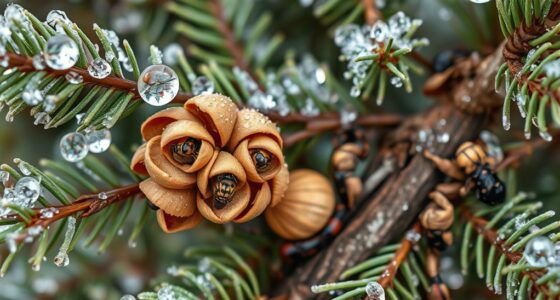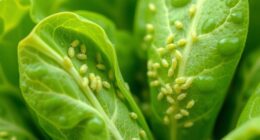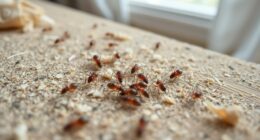To break pest cycles during fall, clear out debris, fallen leaves, and yard clutter to eliminate hiding spots. Properly store outdoor food and waste in sealed containers away from your home. Trim overgrown vegetation and prune branches to improve airflow and reduce pest habitats. Seal cracks and entry points around your home to prevent pests from getting inside. Regular gutter cleaning and scheduling professional inspections further help keep pests at bay—discover more ways to protect your property as you continue.
Key Takeaways
- Remove yard debris, leaves, and clutter to eliminate pest hiding spots and reduce mold growth.
- Seal entry points around doors, windows, and foundation to prevent pests from entering your home.
- Regularly clean gutters and downspouts to avoid water pooling and pest breeding sites.
- Prune overgrown vegetation and maintain landscaping for proper airflow and reduced pest habitats.
- Schedule professional pest inspections to detect and address infestations early before they escalate.
Clearing Out Debris and Fallen Leaves
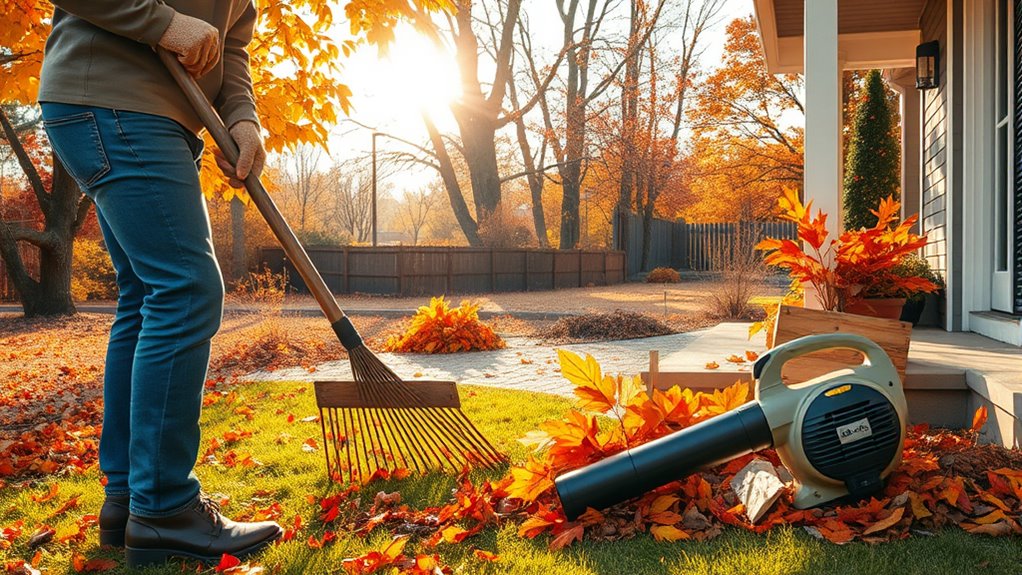
As autumn winds scatter leaves and debris across your yard, it is essential to stay ahead to prevent buildup. Regular leaf removal helps keep your lawn healthy and free of pests that thrive in decaying matter. Focus on debris clearance by raking or using a leaf blower to gather fallen leaves and twigs. Clearing out debris from gutters, flower beds, and around your home’s foundation reduces hiding spots for pests like rodents and insects. Don’t let leaves accumulate in low spots or under shrubs, as damp debris can attract pests and create mold. Staying proactive with leaf removal and debris clearance keeps your yard tidy, protects your plants, and minimizes pest problems during fall. Consistent cleanup makes your yard safer and easier to maintain throughout the season. Incorporating color accuracy into your cleanup tools, such as using proper lighting, can help identify hidden debris and pest activity more effectively.
Properly Store Outdoor Food and Waste
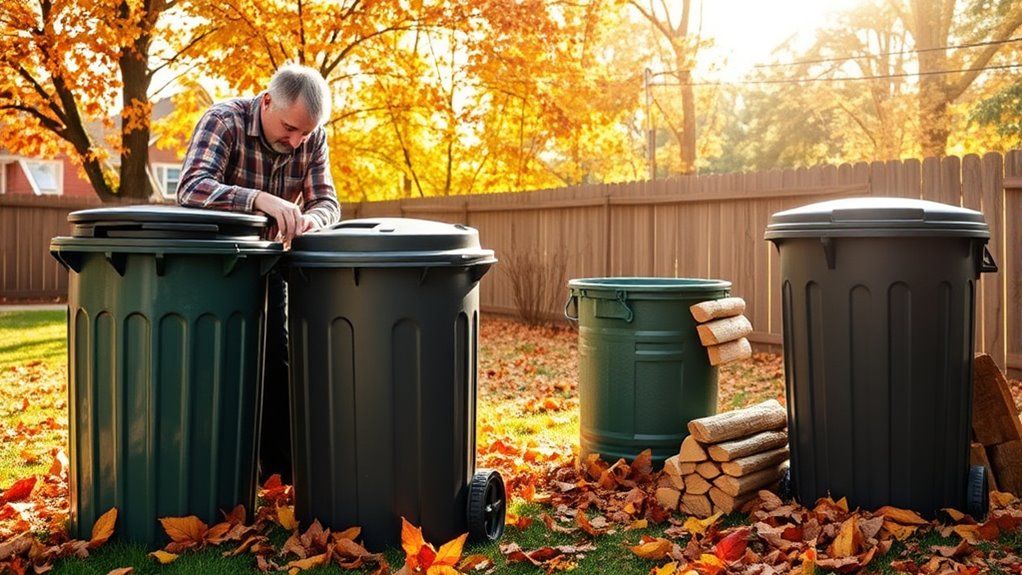
To prevent critters from getting into your outdoor food and waste, make sure to seal food containers tightly. Properly dispose of trash and clean recycling areas regularly to keep pests away. Taking these steps helps protect your yard and maintains a tidy outdoor space. Additionally, ensure that any leftover or spoiled food is identified and discarded promptly to prevent attracting pests Signs of spoilage.
Seal Food Containers Tight
Sealing food containers tightly is essential for keeping outdoor food and waste secure from pests and wildlife. Proper food storage begins with using containers that seal well, preventing smells that attract insects and animals. Container sealing ensures that no odors escape, which can draw raccoons, squirrels, or insects to your yard. Always double-check that lids are secure and airtight, especially when storing leftovers or open packages. Clear, durable containers with tight-fitting lids make it easy to monitor contents and maintain freshness while keeping pests out. Avoid leaving food exposed or loosely covered, as this invites unwanted visitors. By focusing on effective food storage and guaranteeing proper container sealing, you reduce the risk of pest problems and create a safer, cleaner outdoor space. Using airtight containers is also crucial to prevent the escape of scent molecules that attract pests.
Dispose of Trash Properly
Properly storing outdoor trash is essential for preventing pests from being attracted to your yard. Always keep garbage bins and trash containers tightly sealed to prevent odors from escaping. Place trash containers away from your home’s foundation to reduce the chances of pests finding an easy entry point. Empty and clean your bins regularly to eliminate residual food particles that lure pests like rodents and insects. Use sturdy, pest-proof containers if possible, especially during fall when pest activity increases. Avoid overfilling trash cans, and ensure lids are secure after each use. By maintaining clean, sealed trash containers, you cut off pests’ access to food sources, helping break their cycle and keeping your yard pest-free during fall and beyond. Proper storage of outdoor waste is also crucial in minimizing pest attraction.
Clean Recycling Areas
Are your recycling areas inviting pests? Properly storing outdoor food and waste is essential to break pest cycles. Start with recycling station organization—ensure bins are tightly sealed and away from your home’s foundation. Regularly rinse recyclables to eliminate odors that attract pests, and keep lids secure. Compost bin maintenance is equally important; cover organic waste and turn the compost frequently to prevent odors from escaping. Clear out any old or overflowing materials and avoid leaving food scraps exposed. Maintaining proper storage techniques helps prevent pests from being attracted to your outdoor spaces. By keeping your recycling areas tidy and well-maintained, you reduce pest attractants and create an environment less inviting to rodents and insects. A clean, organized recycling station is a simple yet effective step toward fall pest control.
Trim Overgrown Vegetation and Shrubs
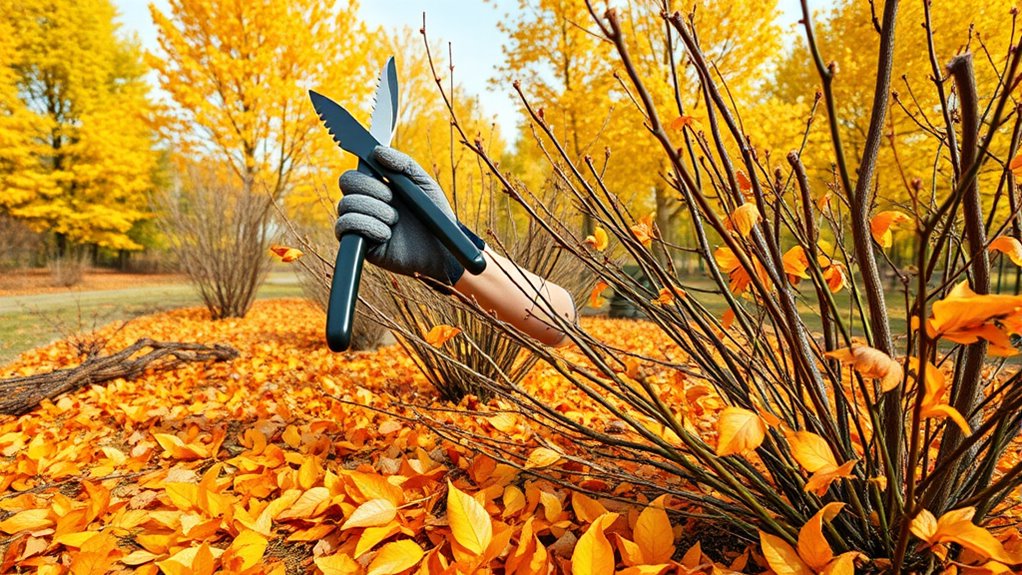
To keep your yard healthy, start by pruning dead branches from your shrubs and trees. Shaping the plants also improves airflow, reducing the risk of disease and pests. Taking these steps now will help your landscape look tidy and thrive through the seasons. Incorporating data analytics into your landscape management can further optimize your yard’s health and pest prevention strategies.
Prune Dead Branches
Removing dead branches is essential for maintaining the health and appearance of your trees and shrubs. Pruning dead or damaged branches encourages spring pruning and prevents pest infestations. Proper branch removal also improves airflow and sunlight penetration, reducing disease risk. Use sharp tools to make clean cuts just outside the branch collar. Focus on overgrown vegetation and shrubs that hinder growth or pose safety risks. Here’s a quick guide:
| Step | Action | Tips |
|---|---|---|
| 1 | Identify dead branches | Look for discoloration or decay |
| 2 | Use proper tools | Pruners or loppers for clean cuts |
| 3 | Make precise cuts | Avoid tearing bark |
| 4 | Remove clearly dead wood | Focus on overgrown areas |
| 5 | Dispose of debris | Prevent pest habitats |
This targeted branch removal supports healthier plants and a pest-free yard. Additionally, maintaining well-pruned plants can help prevent pest infestations, contributing to a healthier outdoor environment.
Shape for Airflow
Properly shaping overgrown vegetation and shrubs enhances airflow throughout your yard, which helps reduce humidity and prevent fungal diseases. Focus on good ventilation design by trimming plants so they don’t block airflow paths. Maintain a clear space between shrubs and structures to promote airflow optimization, preventing stagnant air pockets that attract pests. Avoid overcrowding by selectively pruning branches and removing overly dense growth. This not only improves air circulation but also allows sunlight to reach the soil, discouraging mold and mildew. Regular trimming encourages a healthy environment for your plants and minimizes pest habitats. Additionally, understanding best free keto diet app options can motivate ongoing yard maintenance by setting achievable goals for your outdoor space. Remember, well-shaped plants facilitate better ventilation, helping your yard stay dry and pest-resistant during fall cleanup.
Seal Entry Points and Cracks in Your Home
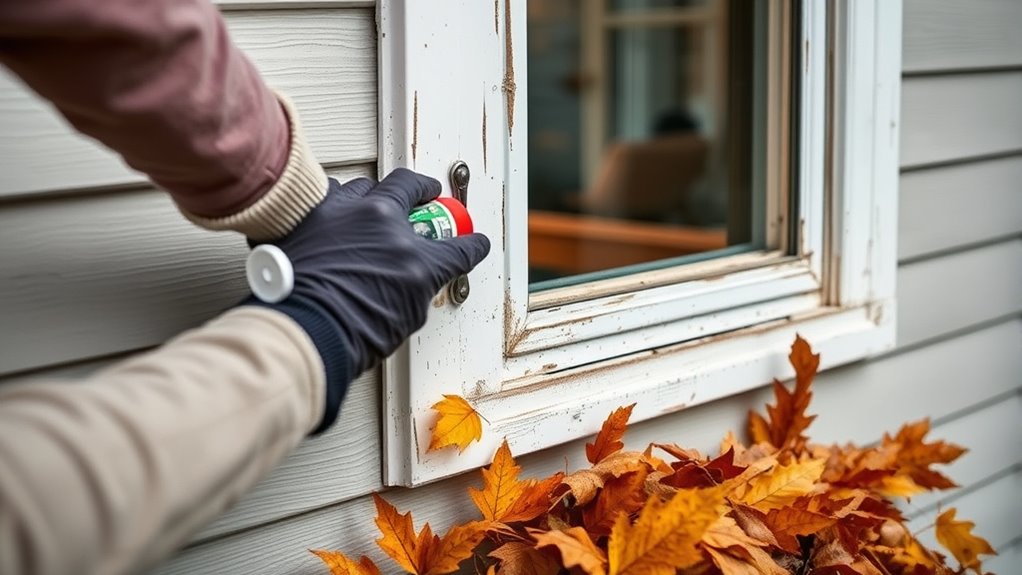
Sealing entry points and cracks is a crucial step in your fall cleanup, as it helps prevent cold drafts and keeps pests out. Start with entry point identification by inspecting your home’s exterior—look around doors, windows, vents, and foundation walls. Pay close attention to small gaps or holes that pests could use to enter. Once identified, focus on crack sealing using weatherproof caulk or foam insulation. Proper crack sealing not only blocks pests but also improves energy efficiency. Don’t forget to check behind appliances and in basement areas. Additionally, understanding the importance of Gold IRA rollovers can provide long-term financial security if you plan to invest in precious metals as part of your overall strategy. By sealing these vulnerabilities, you reduce pest access points and create a less inviting environment for critters seeking warmth. This proactive approach helps break pest cycles before they become an indoor problem.
Clean Gutters and Downspouts
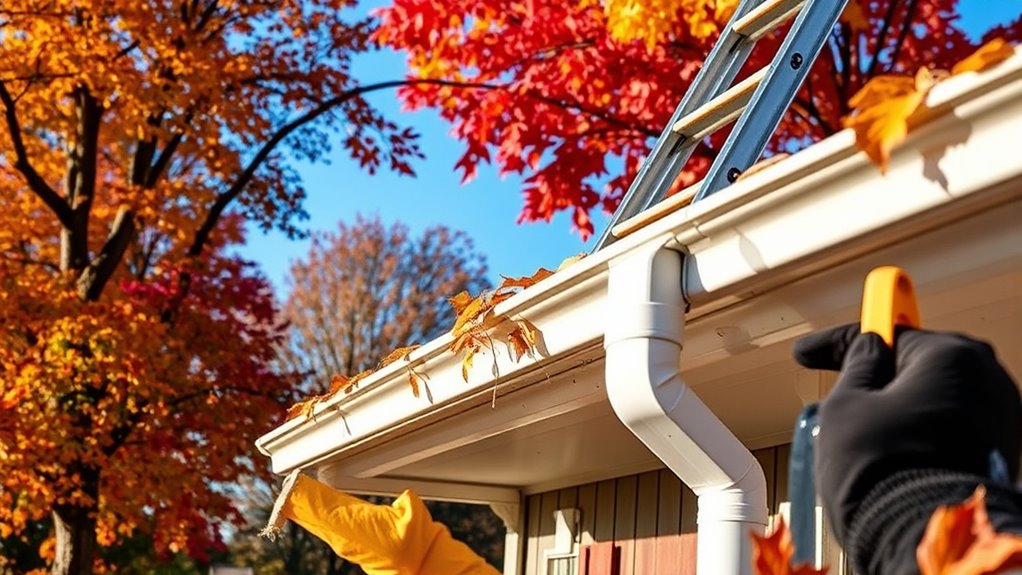
As autumn leaves start to fall, it’s essential to regularly clean your gutters and downspouts to prevent clogs and water damage. Gutter maintenance keeps water flowing smoothly, avoiding leaks that attract pests like mosquitoes and insects. Downspout clearing ensures water doesn’t pool near your foundation, which can lead to structural issues. Visualize this:
| Emotion | Impact |
|---|---|
| Relief | No messy water backups |
| Confidence | Home stays pest-free |
| Safety | Foundation remains strong |
Regular inspection of your drainage system can help identify potential issues early and prevent costly repairs.
Dispose of Yard Clutter and Unused Items
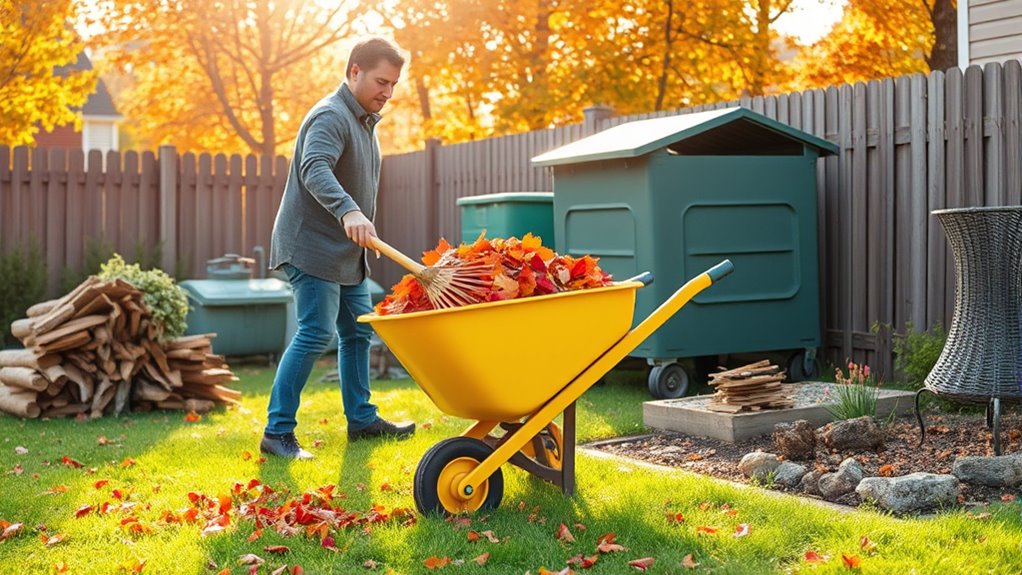
Clearing out yard clutter and unused items is a essential step in preparing your outdoor space for fall. Start by removing yard debris like fallen leaves, broken branches, and leftover plant material, which can attract pests. Gather unused tools, old pots, and broken equipment, then decide whether to store, donate, or discard them. Disposing of these items reduces hiding spots for insects and rodents, breaking pest cycles before winter sets in. Be thorough: clear out clutter from sheds, corners, and under bushes. Proper disposal prevents pests from nesting or foraging in your yard. Keep pathways clear, and make sure no debris or unused tools remain to create inviting environments for pests during the colder months. A tidy yard is less attractive to pests and easier to maintain.
Maintain Compost Bins and Garden Supplies
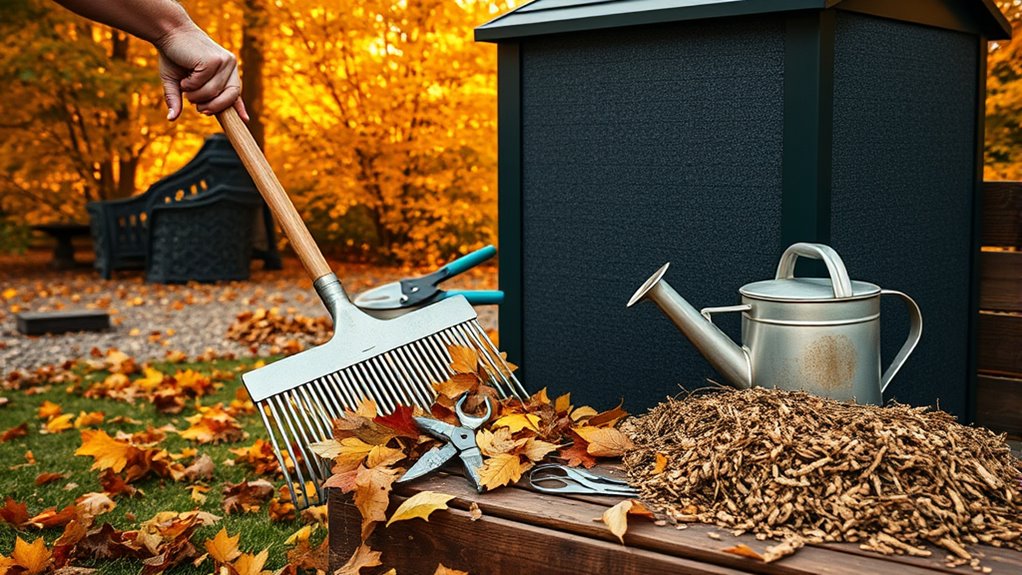
To guarantee your compost bin functions efficiently through fall and winter, regularly check and turn the contents to maintain proper aeration and moisture levels. Compost maintenance is essential to prevent odors and discourage pests from nesting. Keep the compost covered with a breathable lid or tarp to protect it from excess moisture and pests. Additionally, organize your garden supplies by cleaning and storing tools properly, reducing clutter that pests can hide in. Clear fallen leaves and debris from around your compost area to minimize pest habitats. Proper garden supply organization makes it easier to monitor and maintain your supplies, preventing pest infestations. Staying on top of compost maintenance and keeping your garden supplies tidy helps break pest cycles and promotes a healthier, pest-free yard during the colder months.
Schedule a Professional Pest Inspection
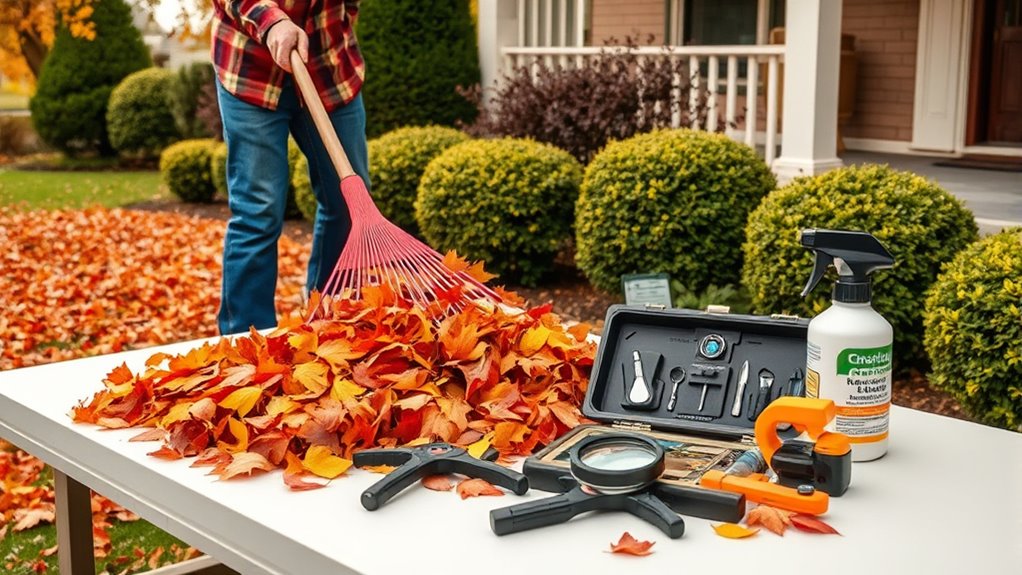
Maintaining your compost bins and organizing garden supplies helps keep pests at bay, but some issues may still go unnoticed. That’s why scheduling a professional pest inspection is essential. Pest detection isn’t always obvious, and pests can hide in hard-to-reach areas. A trained pest control specialist can identify early signs of infestations before they become serious problems. Inspection scheduling allows you to catch pest issues early, saving you time and money in the long run. Regular professional inspections give you peace of mind, knowing your property is thoroughly checked for pests. Don’t wait until you see visible damage—proactive pest detection is your best defense against breakouts that could ruin your fall cleanup efforts.
Frequently Asked Questions
How Often Should I Perform Fall Pest Inspections?
You should perform fall pest inspections at least once a month, especially during peak seasonal pest trends. Regular inspections help you spot signs of pests early and prevent infestations from worsening. Timing is key, so focus on areas where pests hide or enter your home. By staying proactive, you can address issues before winter sets in, making your fall cleanup more effective and reducing the chances of pests returning.
What Specific Pests Are Most Active During Fall?
During fall, certain pests become especially active. You’ll notice increased rodent activity as they seek shelter and food, often hiding in leaf litter around your property. Additionally, pests like spiders and wasps may seek warm indoor spaces. To prevent infestations, you should regularly clear leaf litter and debris, eliminate hiding spots, and seal any entry points. Staying proactive helps break pest cycles and keeps your home pest-free during the colder months.
Can Landscaping Changes Reduce Pest Attraction?
You might wonder if landscaping changes can really reduce pest attraction. Research suggests that thoughtful landscape design, such as removing standing water and trimming dense shrubbery, can act as natural pest deterrents. By creating open, well-maintained spaces, you limit hiding spots and food sources for pests. Incorporating pest-resistant plants and strategic placement of mulch also helps. These adjustments make your yard less inviting, helping break pest cycles effectively.
Are There Eco-Friendly Pest Prevention Methods for Fall?
You can prevent pests eco-friendly this fall by practicing composting tips that reduce attractants, like turning compost regularly and avoiding meat or dairy. Use wildlife deterrents such as natural repellents or fencing to keep animals away without harming them. Additionally, clear fallen leaves and debris, and plant pest-resistant varieties. These simple steps help break pest cycles naturally, keeping your yard healthy and pest-free without chemicals.
How Do Weather Patterns Influence Pest Cycles in Fall?
Weather patterns greatly influence pest cycles in fall by prompting weather adaptation and pest migration. Cooler temperatures and changing humidity levels signal pests to seek shelter, affecting their movement and reproduction. Mild falls may prolong pest activity, while early frosts can force pests into your home sooner. By understanding these patterns, you can better anticipate pest behavior, making it easier to implement eco-friendly prevention methods and break their cycle effectively.
Conclusion
Think of fall cleanup as sweeping away the debris that invites pests in. When you clear leaves, store food properly, trim overgrowth, and seal cracks, you’re building a fortress that pests can’t breach. Regular maintenance is your shield, breaking the cycle before it starts. Stay proactive, and your home will stand strong like a well-guarded fortress, ready to withstand the season’s unwelcome visitors. Keep up these strategies, and pests won’t have a foothold to take hold.



